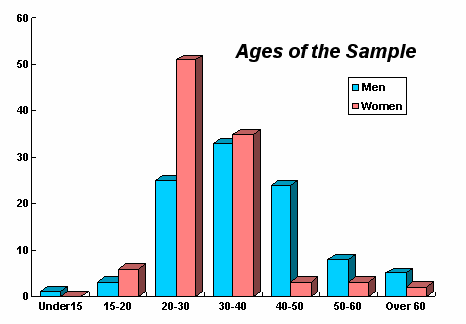
Age breakdown of men and women who responded
The world's commonest surgical operation is circumcision - the removal of the foreskin of the male penis. Medical research has told us plenty about the effects of circumcision from the health point of view, though the information hasn't always been accurately reported by the popular press. But (with one or two honourable exceptions) medical studies have neglected two questions which are of fundamental importance to the man and woman (and boy and girl) on the street. First, how do people feel about it? Do men prefer to have their penis in its natural state or circumcised? Do women like their men to have a foreskin or not? Second, how does it affect sex? It must make some difference for the man, but is it better, worse or just different? Does it make any difference to a woman which sort of partner she has?
These were the sorts of questions I set out to answer when I started to research circumcision. As a starting point, with the very generous assistance of the Australian edition of Forum magazine and the Family Planning Association of NSW, a survey of both men's and women's attitudes was carried out in 1989. Australia is perhaps the ideal country for such a survey. Circumcision, while popular, was never as universal as in the USA, so we were able to get plenty of both sorts of men responding. And the operation has never, in Australia, had a strong association with social class (as it did in the UK), or with ethnic group (as it does in the USA). We could get as close as anyone is likely to get to unbiased information - information relevant to anyone, anywhere who is interested in circumcision.
The "Great Circumcision Questionnaire" was published twice in Australian Forum magazine (J. Badger, Australian Forum volume 2, numbers 1, 1988, original forms and introductory article). This brought forth a predominantly male response - just over two thirds of the forms came from men. Several of the female responses came as part of 'his and hers' answers from couples, which added an interesting extra dimension to the survey. For these we could compare two views of the same penis! The questionnaire was also put out for a couple of weeks in the waiting rooms of the Sydney clinics of the Family Planning Association of NSW. The FPA responses also came from both sexes, but this time women were in the majority, reflecting the predominantly female clientele of these particular clinics. Copies of the questionnaire were evidently passed around in all sorts of ways - photocopied, faxed to friends, and even filled out over the telephone. We received one batch from the staffroom of a Queensland High School (which was great, but it would have been even better if they had passed it on to the pupils as well!) The survey was strictly anonymous so that, we hoped, nobody would feel inhibited about answering frankly.

Age breakdown of men and women who responded
The survey brought in 191 replies, 85 from men and 106 from women. The ages of the respondents ranged from under 15 to over 60, so they cover the full spectrum of the sexually active population. The chart shows the breakdown of the ages. Most of the men were over 20 and under 50, with a third in the 30 to 40 age group. The women were younger, mostly aged from 20-40 with over half in the 20-30 age range. Of the men, 70% were circumcised and 30% were not. The figures for the current or most recent lover of the women tallied closely with this - 70% circumcised and 30% natural. So in 1989 70% of Australian males of sexually active age had been circumcised, and 30% still had foreskins. The report of this survey was published in two articles Australian Forum, volume 2 numbers 12 & 13, 1989.
As a followup, in late 1995 I put out the survey forms to several news groups on the Internet. This brought in 91 entries, with an international range but a strong North American bias. This wasn't the only bias - three-quarters were from men, of whom 40% were gay. Almost half of the men, and a quarter of the women, were identified as members of anti-circumcision campaign groups. (One described herself, rather nicely, as an "intactivist"). Of the remainder, a few were from members of a pro-circumcision group! What had happened was that these organizations had (quite legitimately) passed the forms around their Internet mailing lists and discussion groups, which gave us a very large proportion of the returns were from those with strong axes to grind. It was, in fact, very interesting to find out something about these people, but to treat them as a representative sample was clearly impossible. I have, therefore, used the Net data mainly for such general matters as length of foreskin or type of circumcision.
Home